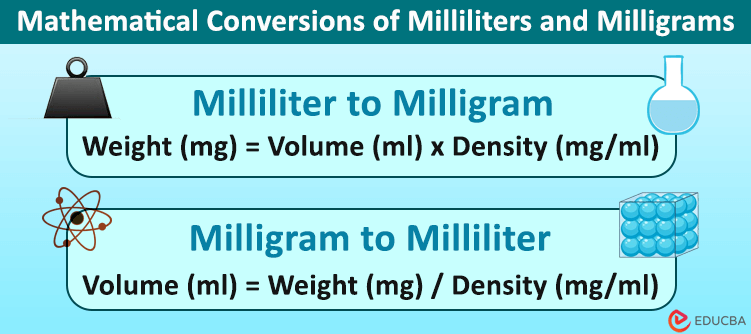Updated December 21, 2023
Introduction to Milliliters and Milligrams
In scientific knowledge, precision in measurement is important as it guides researchers, scientists, and students in the interpretation of data. Among the units, two units commonly focused on in education are milliliters and milligrams. In this article, we will study the importance of these two units in education, examining their applications in different areas of study. It will also help educators use effective teaching approaches to help students understand milliliters and milligrams and apply them accurately in their scientific understanding.
Fundamentals of Measurement
It is important to understand the fundamentals of measurement before getting into the details of ml to mg conversions. These units are essential components of the metric system, a standardized global system for scientific and everyday measurements.
Milliliter, denoted by ml, is a unit to measure volume, particularly for liquids or solution measurements. Meanwhile, milligrams, denoted by mg, are units to measure mass. This unit is frequently used in pharmaceuticals, chemistry, and different scientific fields to quantify the weight of substances.
Moreover, these two units have real-world applications.
For example, a barista (one who makes coffee) measures the volume of coffee in ml and the quantity of caffeine in mg. This practical example helps us see how milliliters and milligrams units work in our day-to-day experiences.
Mathematical Conversions of Milliliters and Milligrams
Let’s see the conversion of milliliters and milligrams using the following formulas.
The formula to calculate weight will be,
500 ml × 0.8 mg/ml = 400 mg.
So, the overall weight of that liquid substance in 500 ml is 400 mg.
Applications in Science
Understanding milliliters and milligrams is crucial in scientific measurements.
- In chemistry, milliliters are important for measuring liquids and making solutions for accurate reactions and analyses.
- Conversely, milligrams play a crucial role in pharmacology. Pharmacologists need to precisely measure the number of active ingredients to add to the drug to ensure the correct dosage. This careful measurement is vital in preventing ineffective medication due to underdosing and adverse effects from overdosing.
In scientific research, clear communication is critical, and errors in unit measurement can lead to incorrect results, potentially risking experiment reliability. Educators play a crucial role in explaining the significance of using correct units in scientific writing and research. For research clarity, students must understand the importance of dealing with a substance’s volume (in milliliters) and mass (in milligrams). This precision ensures that others can replicate experiments accurately, building upon existing knowledge without confusion.
Educational Activities for Learning
Educators can ensure a solid understanding of milliliters and milligrams through various interactive activities and experiments. These activities serve to clear theoretical concepts and actively engage students in learning.
For instance, one such activity might involve measuring and comparing the volume and weight of different liquids and solids commonly found in a kitchen. Students can use tools like graduated cylinders for liquids and digital scales for solids. This exercise will enhance students’ measuring skills and help them distinguish between milliliters and milligrams.
Moreover, educators can design experiments that require students to convert mg to ml, promoting a practical understanding of the mathematical relationships between these units. For example, educators can give students a substance of known weight in milligrams and ask them to calculate its volume in milliliters.
Teaching Strategies
Educators can also use innovative teaching strategies to make the educational journey of understanding milliliters and milligrams informative and enjoyable. Some of the strategies are as follows.
1. Visual Aids
They can use diagrams, charts, and graphics to explain the concepts of milliliters and milligrams. They can also show comparison tables or charts for better retention and understanding.
2. Interactive Technology
They can use educational apps and simulations that allow students to interact with virtual measurements. They can also use multimedia presentations to make the learning experience dynamic and engaging.
3. Real-World Context
Educators can incorporate lessons to show real-world applications of milliliters and milligrams in various fields, such as medicine, food science, and environmental studies. They can invite guest speakers from relevant industries to share practical insights, giving students a glimpse into the professional applications of these concepts.
Final Thoughts
A clear understanding of milliliters and milligrams is crucial in education. These units are the foundation for accurate measurement in scientific research and daily life. Educators equipped with effective teaching strategies can help students recognize the importance of these units and initiate them on a path to scientific proficiency. It will prepare them to face the challenges of their future endeavors.
Recommended Articles
We hope this article on “Difference Between Milliliters and Milligrams in Education” was informative and beneficial. To learn about related articles, refer to the below articles.


